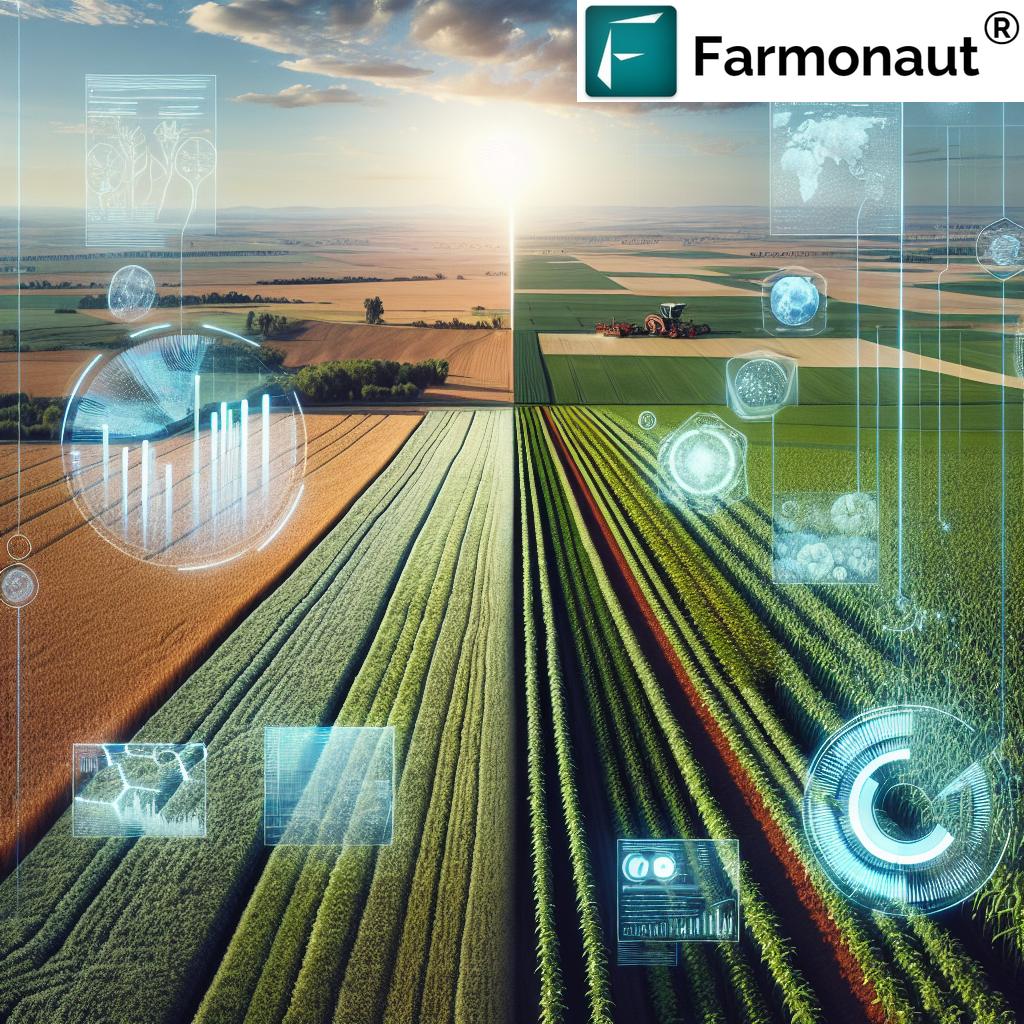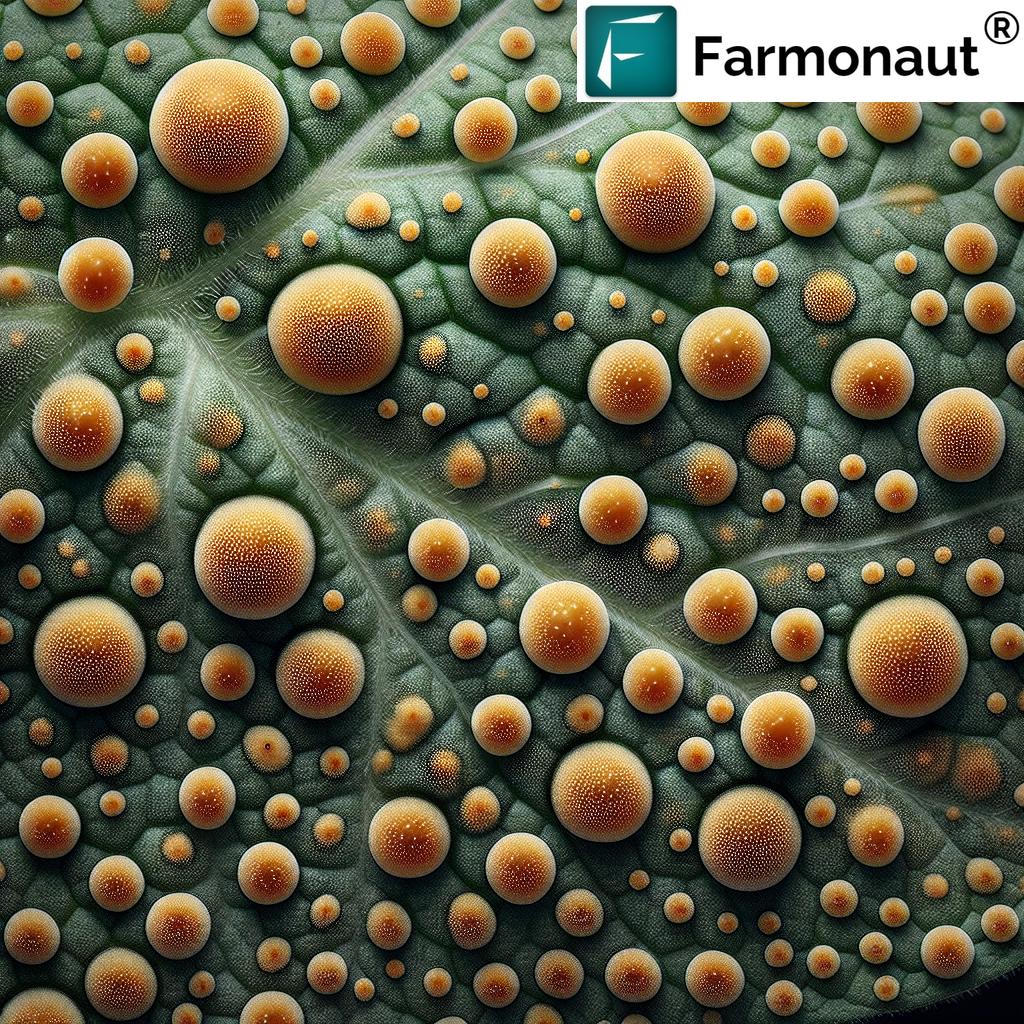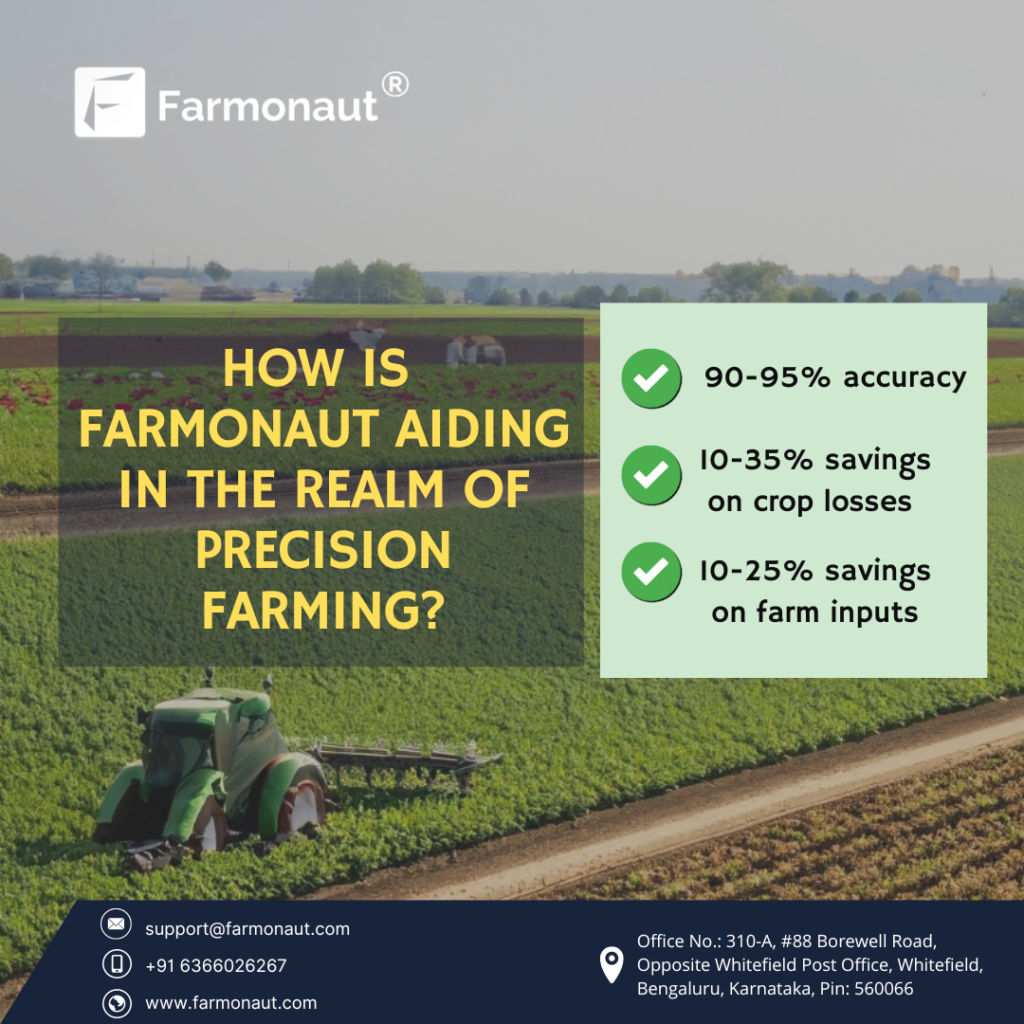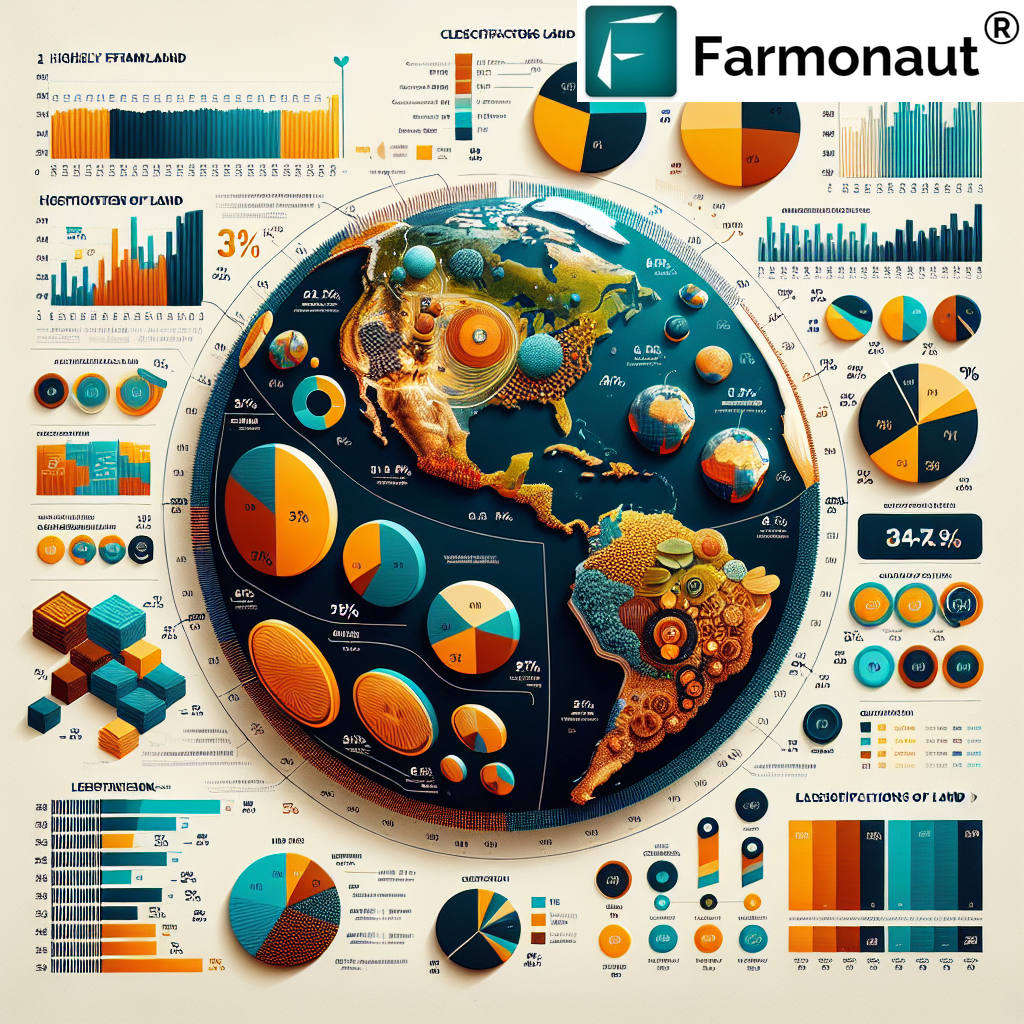Optimize Pesticide Spraying: Farmonaut’s AI-Driven Weather Monitoring for Effective Pest Control
“AI-driven weather monitoring can reduce pesticide waste by up to 30% through optimized application timing.”
In the ever-evolving world of agriculture, effective pest control remains a critical challenge for farmers worldwide. As we navigate the complexities of modern farming, understanding the intricate relationship between weather factors and pesticide application has become paramount. In this comprehensive guide, we’ll explore how Farmonaut’s cutting-edge AI-driven weather monitoring technology is revolutionizing pest management strategies, helping farmers optimize their pesticide spraying techniques for maximum efficacy and minimal environmental impact.
The Crucial Role of Weather in Pesticide Application
When it comes to pesticide spraying, timing is everything. The effectiveness of pest control measures hinges on a delicate balance of various weather factors. Let’s delve into the key weather elements that play a pivotal role in determining the success of your pesticide application:
- Temperature: Impacts pesticide efficacy and evaporation rates
- Wind: Affects spray drift and coverage
- Humidity: Influences droplet size and evaporation
- Precipitation: Determines the risk of pesticide washoff
Understanding these weather factors for pesticide application is crucial for farmers aiming to achieve optimal results while minimizing waste and environmental impact. Farmonaut’s advanced agritech solutions provide real-time, hyper-local weather data to help you make informed decisions about when and how to apply pesticides effectively.
Temperature: The Cornerstone of Pesticide Efficacy
Temperature plays a pivotal role in determining the effectiveness of pesticide applications. Let’s explore how temperature affects various aspects of pest control:
Optimal Temperature Ranges
Most pesticides work best within specific temperature ranges, typically between 10°C and 25°C (50°F to 77°F). Within this range, pesticides are more likely to be absorbed by plants and insects, leading to improved efficacy. However, it’s essential to note that different types of pesticides may have varying optimal temperature ranges, so always consult the product label for specific guidelines.
Temperature Effects on Pesticide Efficacy
- Evaporation: Higher temperatures increase evaporation rates, potentially reducing the amount of pesticide that reaches its target.
- Volatilization: Some pesticides may volatilize (turn into vapor) more readily at higher temperatures, leading to reduced effectiveness and increased drift risk.
- Plant Metabolism: Warmer temperatures can accelerate plant metabolism, potentially enhancing the absorption and translocation of systemic pesticides.
- Insect Activity: Many insects become more active at higher temperatures, potentially increasing their exposure to pesticides.
By leveraging Farmonaut’s AI-driven weather monitoring, farmers can pinpoint the ideal temperature windows for pesticide application, maximizing effectiveness while minimizing waste and environmental impact.
Wind: The Double-Edged Sword of Pesticide Application
Wind is a critical factor in pesticide spraying, capable of both enhancing and hindering your pest control efforts. Let’s examine the various ways wind impacts pesticide application:
Wind and Pesticide Drift
Pesticide drift occurs when spray droplets are carried away from the target area by wind. This can lead to several issues:
- Reduced efficacy due to insufficient pesticide reaching the intended target
- Potential damage to non-target crops or plants
- Environmental contamination of nearby water bodies or natural habitats
- Health risks to humans or animals in adjacent areas
Optimal Wind Conditions for Spraying
Generally, the ideal wind speed for pesticide application ranges from 3 to 15 km/h (2 to 9 mph). This gentle breeze helps with even distribution of the spray while minimizing drift risk. However, it’s crucial to consider the following factors:
- Spray droplet size: Smaller droplets are more susceptible to drift, so adjust your nozzles accordingly.
- Wind direction: Always spray perpendicular to the wind direction to minimize drift.
- Buffer zones: Maintain appropriate buffer zones near sensitive areas to prevent unintended pesticide movement.
Farmonaut’s advanced weather monitoring technology provides real-time wind data, allowing farmers to make informed decisions about the optimal timing and technique for pesticide application.
Humidity: The Silent Influencer of Spray Efficacy
Relative humidity plays a crucial role in pesticide application, affecting both the longevity and effectiveness of the spray. Let’s explore the humidity impact on pesticide application:
Optimal Humidity Ranges
The ideal relative humidity for pesticide application typically falls between 40% and 70%. Within this range, pesticides are less likely to evaporate quickly and more likely to adhere to plant surfaces effectively.
Humidity Effects on Pesticide Performance
- Droplet size: Higher humidity can help maintain larger droplet sizes, reducing drift risk.
- Evaporation rates: Lower humidity leads to faster evaporation, potentially reducing pesticide efficacy.
- Absorption: Moderate humidity levels can enhance pesticide absorption by keeping leaf surfaces moist.
- Degradation: Extremely high humidity may accelerate chemical breakdown of certain pesticides.
By utilizing Farmonaut’s AI-driven weather monitoring, farmers can identify the optimal humidity conditions for pesticide application, ensuring maximum effectiveness and longevity of the treatment.
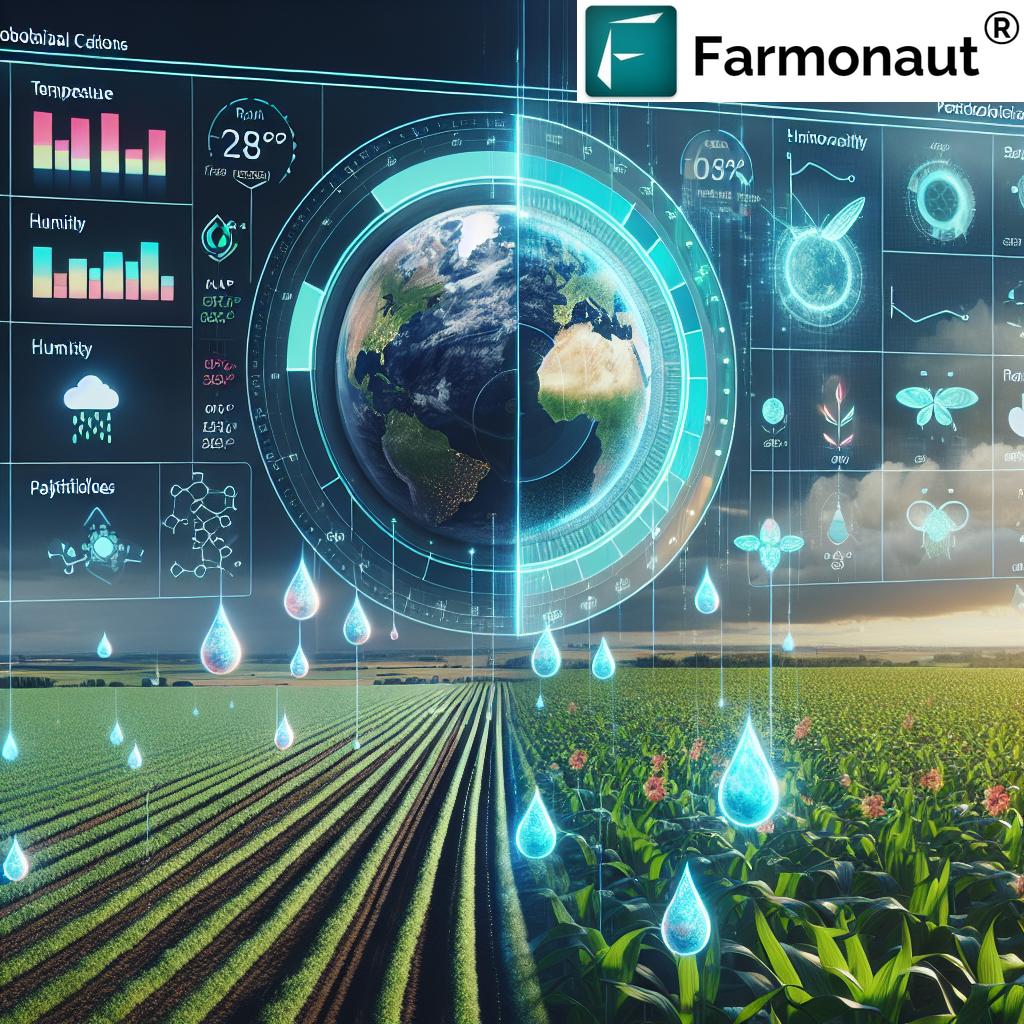
Precipitation: Timing is Everything
Rainfall is a critical factor to consider when planning pesticide applications. Proper timing in relation to precipitation events can significantly impact the effectiveness of your pest control measures. Let’s examine the key considerations:
Optimal Timing for Pesticide Application
As a general rule, it’s best to apply pesticides when there’s no rain forecast for at least 24 hours after application. This allows sufficient time for the pesticide to dry on plant surfaces and begin its intended action. However, the specific timing may vary depending on the type of pesticide used:
- Contact pesticides: Require a shorter rain-free period (typically 1-2 hours) as they act on contact with the pest.
- Systemic pesticides: Need more time (often 24 hours or more) to be absorbed by the plant before rainfall.
Impacts of Precipitation on Pesticide Efficacy
- Washoff: Rain can wash pesticides off plant surfaces, reducing their effectiveness.
- Dilution: Precipitation may dilute the concentration of pesticides, potentially rendering them less potent.
- Runoff: Heavy rainfall shortly after application can lead to pesticide runoff, causing environmental concerns.
- Absorption: Light rainfall or high humidity following application can sometimes enhance the absorption of systemic pesticides.
Farmonaut’s advanced weather forecasting capabilities allow farmers to plan their pesticide applications with precision, avoiding potential washoff and maximizing the impact of their pest control efforts.
The Delta T Spraying Scheduler: A Game-Changer in Pesticide Application
One of the most innovative tools in modern pest management is the Delta T spraying scheduler. This advanced technology combines temperature and humidity data to provide farmers with a powerful decision-making tool for optimizing pesticide application timing.
What is Delta T?
Delta T is the difference between the wet bulb and dry bulb temperatures. It serves as an indicator of evaporation potential and is crucial for determining ideal spraying conditions.
How Delta T Improves Pesticide Application
- Optimal spraying windows: Identifies the best times for pesticide application based on evaporation rates.
- Drift risk assessment: Helps predict the likelihood of spray drift under current weather conditions.
- Efficacy optimization: Ensures pesticides are applied when they’re most likely to be effective.
- Resource conservation: Reduces waste by preventing applications during unfavorable conditions.
Farmonaut’s AI-driven weather monitoring system incorporates Delta T calculations, providing farmers with real-time insights for optimal pesticide application timing.
“Proper pesticide application during ideal weather conditions can increase crop yield by 15-20% compared to poorly timed spraying.”
Temperature Inversion in Agriculture: A Hidden Threat to Effective Spraying
Temperature inversions pose a significant challenge to pesticide application, often going unnoticed but potentially causing severe issues. Understanding and avoiding these conditions is crucial for effective and responsible pest management.
What is a Temperature Inversion?
A temperature inversion occurs when a layer of warm air sits above a layer of cooler air near the ground, contrary to the normal temperature gradient. This phenomenon can trap pesticide droplets in the air, leading to off-target movement and reduced efficacy.
Identifying Temperature Inversions
- Time of day: Most common in early morning or late evening
- Wind speed: Typically occurs when wind speeds are less than 3 km/h
- Fog or dew: Often accompanied by ground-level fog or heavy dew
- Smoke patterns: Smoke moving horizontally rather than rising can indicate an inversion
Mitigating Inversion Risks
To avoid the dangers associated with temperature inversions, consider the following strategies:
- Avoid spraying during high-risk periods (early morning, late evening)
- Use Farmonaut’s AI-driven weather monitoring to identify potential inversion conditions
- Adjust spray techniques, such as using larger droplet sizes or lower boom heights
- Consider alternative pest control methods during high-risk periods
By leveraging Farmonaut’s advanced weather monitoring technology, farmers can identify and avoid temperature inversion conditions, ensuring more effective and environmentally responsible pesticide applications.
Optimizing Pesticide Application Timing with Farmonaut’s AI-Driven Solutions
Farmonaut’s cutting-edge agritech solutions offer farmers unprecedented access to real-time, hyper-local weather data, revolutionizing the way we approach pesticide application timing. Let’s explore how these innovative tools can help you maximize the effectiveness of your pest control strategies:
Real-Time Weather Monitoring
Farmonaut’s platform provides up-to-the-minute weather data specific to your field location, including:
- Temperature
- Wind speed and direction
- Relative humidity
- Precipitation forecasts
- Delta T calculations
This comprehensive weather monitoring allows farmers to make informed decisions about the optimal timing for pesticide application, considering all relevant factors simultaneously.
AI-Powered Predictive Analytics
Farmonaut’s advanced AI algorithms analyze historical weather patterns, current conditions, and forecasts to provide:
- Customized spraying window recommendations
- Drift risk assessments
- Pest pressure predictions
- Crop-specific application timing suggestions
These predictive insights enable farmers to plan their pest management strategies proactively, optimizing resource allocation and maximizing crop protection efficacy.
Mobile Accessibility
Farmonaut’s weather monitoring and pesticide application optimization tools are available through user-friendly mobile apps, allowing farmers to access critical information anytime, anywhere. This mobile accessibility ensures that you can make timely decisions even when you’re in the field.
Access Farmonaut’s powerful tools:
Integrating Weather Data for Precision Pest Management
For developers and agribusinesses looking to harness the power of Farmonaut’s weather data, our robust API offers seamless integration options. Learn how to incorporate our comprehensive weather monitoring capabilities into your own systems and applications:
Optimal Weather Conditions for Pesticide Application
| Weather Factor | Optimal Range | Impact on Spraying |
|---|---|---|
| Temperature | 10-25°C (50-77°F) | Reduces evaporation, improves absorption |
| Wind Speed | 3-15 km/h (2-9 mph) | Minimizes drift risk, ensures even coverage |
| Relative Humidity | 40-70% | Affects droplet size and evaporation rates |
| Precipitation | No rain forecast for 24 hours | Prevents washoff, ensures pesticide adherence |
Mitigating Environmental Risks in Pesticide Application
While effective pest control is crucial for crop protection, it’s equally important to consider the environmental impact of pesticide use. Farmonaut’s AI-driven weather monitoring helps farmers strike a balance between efficacy and environmental responsibility. Here are some key strategies for mitigating environmental risks:
Precision Application Techniques
- Targeted spraying: Use Farmonaut’s crop health monitoring to identify specific areas requiring treatment, reducing overall pesticide use.
- Variable rate application: Adjust application rates based on real-time weather conditions and crop needs.
- Drift reduction technologies: Implement low-drift nozzles and spray shields to minimize off-target movement.
Environmental Monitoring
- Buffer zones: Establish and maintain appropriate buffer zones near sensitive areas using Farmonaut’s field mapping tools.
- Water quality monitoring: Regularly test nearby water sources to ensure pesticides aren’t contaminating local ecosystems.
- Biodiversity assessment: Use Farmonaut’s satellite imagery to monitor the health of surrounding natural habitats.
Integrated Pest Management (IPM)
Incorporate Farmonaut’s weather data and crop monitoring into a comprehensive IPM strategy:
- Pest pressure forecasting: Use weather data to predict pest outbreaks and time interventions accordingly.
- Biological control integration: Identify optimal conditions for releasing beneficial insects or applying biopesticides.
- Cultural practices: Adjust planting dates, crop rotations, and other practices based on weather patterns to reduce pest pressure naturally.

Maximizing Pesticide Efficacy Through Advanced Weather Forecasting
Farmonaut’s AI-driven weather monitoring doesn’t just provide real-time data; it also offers sophisticated forecasting capabilities that can significantly enhance your pest management strategies. Let’s explore how leveraging these advanced forecasts can help you maximize pesticide efficacy:
Long-Range Weather Forecasts
Farmonaut’s platform provides extended weather forecasts, allowing farmers to plan their pesticide applications well in advance. This foresight enables:
- Strategic timing: Schedule applications during optimal weather windows for maximum effectiveness.
- Resource allocation: Plan labor and equipment usage more efficiently.
- Inventory management: Ensure you have the right pesticides on hand when conditions are ideal.
Micro-Climate Analysis
Farmonaut’s hyper-local weather data accounts for micro-climate variations within your fields, providing:
- Targeted application strategies: Tailor your approach to specific areas of your field based on localized conditions.
- Improved coverage: Adjust application techniques to account for micro-climate effects on spray drift and efficacy.
- Enhanced precision: Minimize waste by applying pesticides only where and when they’re most needed.
Weather-Based Pest Pressure Predictions
By combining weather forecasts with pest life cycle data, Farmonaut’s AI can predict potential pest outbreaks, allowing for:
- Proactive treatments: Apply pesticides preemptively when conditions favor pest development.
- Reduced application frequency: Optimize timing to minimize the number of treatments required.
- Integrated pest management: Incorporate non-chemical control methods when weather conditions are less favorable for pesticide use.
Enhancing Crop Health Monitoring for Targeted Pest Control
Farmonaut’s satellite-based crop monitoring capabilities play a crucial role in optimizing pesticide application strategies. By providing detailed insights into crop health and development, this technology allows farmers to take a more targeted approach to pest management. Let’s explore how these advanced monitoring tools can enhance your pest control efforts:
Vegetation Health Indices
Farmonaut utilizes multispectral satellite imagery to calculate various vegetation health indices, such as NDVI (Normalized Difference Vegetation Index). These indices provide valuable information about:
- Crop vigor: Identify areas of stress that may be more susceptible to pest damage.
- Growth stages: Tailor pesticide applications to specific crop development phases.
- Pest hotspots: Detect early signs of infestation for prompt intervention.
Time-Lapse Imagery
Farmonaut’s platform allows farmers to generate time-lapse visualizations of their fields, offering:
- Historical context: Analyze pest pressure patterns over time.
- Crop development tracking: Align pesticide applications with critical growth stages.
- Efficacy assessment: Evaluate the impact of previous pesticide treatments.
Precision Agriculture Integration
By combining crop health monitoring with weather data and AI-driven insights, Farmonaut enables a truly integrated approach to pest management:
- Variable rate application: Adjust pesticide rates based on crop health and pest pressure in specific zones.
- Targeted scouting: Focus in-field inspections on areas showing potential stress or infestation.
- Resource optimization: Allocate pesticides and application efforts where they’re most needed, reducing waste and environmental impact.
The Future of Weather-Smart Pest Management
As we look ahead, the integration of AI-driven weather monitoring and advanced crop health analysis promises to revolutionize pest management practices. Farmonaut is at the forefront of this agricultural innovation, continuously developing new tools and technologies to help farmers maximize crop protection while minimizing environmental impact.
Emerging Technologies
- Machine learning algorithms: Enhance pest prediction models by analyzing complex patterns in weather, crop health, and historical pest data.
- IoT sensor integration: Combine Farmonaut’s satellite data with ground-based sensors for even more precise local weather and crop health monitoring.
- Automated spray systems: Develop smart sprayers that automatically adjust application rates based on real-time weather conditions and crop health data.
Sustainable Pest Management
The future of pest control is not just about efficacy, but also about sustainability. Farmonaut’s technologies are evolving to support more environmentally friendly pest management practices:
- Biopesticide optimization: Use weather and crop health data to maximize the effectiveness of biological pest control agents.
- Precision ecosystem management: Monitor and maintain beneficial insect populations to reduce reliance on chemical pesticides.
- Carbon footprint reduction: Optimize pesticide use to minimize greenhouse gas emissions associated with production and application.
Conclusion: Empowering Farmers with Weather-Smart Pest Control
In the ever-evolving landscape of modern agriculture, effective pest management requires a sophisticated understanding of the intricate relationship between weather conditions and pesticide efficacy. Farmonaut’s AI-driven weather monitoring and crop health analysis tools provide farmers with unprecedented insights, enabling them to optimize their pest control strategies for maximum effectiveness and minimal environmental impact.
By leveraging real-time, hyper-local weather data, advanced forecasting capabilities, and detailed crop health monitoring, farmers can:
- Precisely time pesticide applications for optimal efficacy
- Reduce waste and environmental risks associated with pest control
- Integrate weather considerations into comprehensive IPM strategies
- Enhance crop yields through more effective pest management
- Promote sustainable farming practices that benefit both agriculture and the environment
As we look to the future, the continued development of AI-driven agritech solutions promises to further revolutionize pest management practices, making them more precise, efficient, and environmentally responsible than ever before.
Embrace the power of weather-smart pest control with Farmonaut’s innovative solutions, and take your farm’s productivity and sustainability to new heights.
FAQs
- How does Farmonaut’s weather monitoring improve pesticide application timing?
Farmonaut provides real-time, hyper-local weather data and AI-driven insights, allowing farmers to identify optimal spraying windows based on temperature, wind, humidity, and precipitation forecasts. - What is Delta T, and why is it important for pesticide spraying?
Delta T is the difference between wet and dry bulb temperatures, indicating evaporation potential. It helps determine ideal spraying conditions to maximize pesticide efficacy and minimize drift. - How can I avoid temperature inversions when applying pesticides?
Use Farmonaut’s weather monitoring to identify potential inversion conditions, typically occurring in early morning or late evening with low wind speeds. Avoid spraying during these high-risk periods. - What are the optimal weather conditions for pesticide application?
Generally, ideal conditions include temperatures between 10-25°C, wind speeds of 3-15 km/h, relative humidity of 40-70%, and no rain forecast for 24 hours after application. - How does Farmonaut’s crop health monitoring enhance pest management?
Farmonaut’s satellite-based crop monitoring provides insights into vegetation health, growth stages, and potential pest hotspots, allowing for more targeted and efficient pesticide applications.







